What is a Ready-Made?
A work is a machine for producing meanings.
— Octavio Paz
When asked whether he considers the ready-mades in the same order of achievement as his other works, Duchamp replied: "They look trivial, but they're not. On the contrary, they represent a much higher degree of intellectuality."[45] In order to elucidate Duchamp's comment, consider in some detail the varieties of gestures embodied in the otherwise trivial appearance of the ready-made. What kind of object is the ready-made? Its three-dimensional character suggests its affinity to sculpture, while its commonplace character suggests that it may be a pun on the objective reality of the work of art. Is the ready-made an artwork or a critical gesture? And if the ready-made is not an artwork, how does it maintain its critical dis-
tance from reverting into a work of art? In this context, what becomes of the artist and the creative act?
The ready-made is the culmination of Duchamp's critique of artistic vision, a critique seeking to transform that vision, to undermine its optical verisimilitude by reinscribing it through verbal and cognitive activity. As the ready-made is often a commonplace object (a bicycle wheel, comb, snow shovel, urinal, and so forth), it engages the spectator in a new dynamic, one where the object is no longer defined by its visual appeal as an aesthetic object. The visual pleasure induced by the formal and material qualities of the object is not rejected; instead, it is deliberately avoided as an intervening criterion in the choice of the ready-mades. As Duchamp explains:
In general, I had to be beware of its "look." It's very difficult to choose an object, because, at the end of fifteen days, you begin to like it or hate it. You have to approach something with an indifference, as if you had no aesthetic emotion. The choice of the readymades is always based on visual indifference and, at the same time, on the total absence of good or bad taste. (DMD , 48)
The experience of the ready-made is one of indifference and anesthesia, since these commonplace objects have been selected because of their lack of "aesthetic emotion," as a defense against "taste" or the spectator's "look." This invocation of "visual indifference" marks Duchamp's turn away from the "visual" arts and toward an art that seeks to define itself in terms of its intellectual, rather than "retinal," potential. It is this lack of aesthetic emotion and taste that distinguishes Duchamp's ready-mades from subsequent experiments, such as the Surrealist found object (objet trouvé). The choice of the found object often relies on its visual appearance, its evocative powers, or its melancholic character.
But as Duchamp admits, no object can resist visual appropriation. Sooner or later, you begin to either like it or hate it, since the object is recovered under the aegis of one's artistic habits as either good or bad taste. How then does one escape taste? Duchamp's solution, in the context of his pictorial work, is to take recourse to "mechanical drawing," which according to him "upholds no taste, since it is outside all pictorial
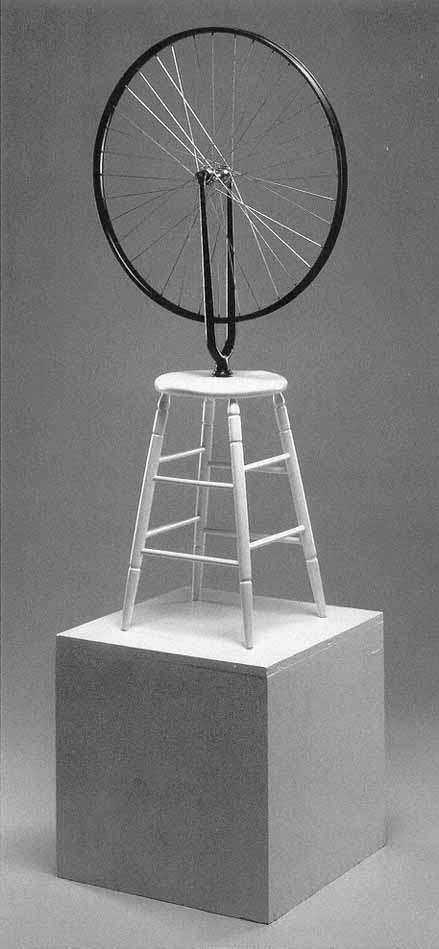
Fig. 40.
Marcel Duchamp, Bicycle Wheel (Roue de bicyclette), 1964 (original version of 1913, lost).
Assisted ready-made: a bicycle fork with its wheel screwed upside down onto a kitchen
stool painted white, height 50 in.
Courtesy of The Philadelphia Museum of Art, Louise and Walter Arensberg Collection.
conventions" (dmd, 48). This appeal to mechanical drawing is intended as an alternative to pictorial conventions, since the technical and schematic aspects of the industrial prototype appear to escape artistic considerations. In choosing actual objects as ready-mades, however, Duchamp extends the notion of "mechanical drawing" to include the objects themselves rather than their models (design prototypes). In making this dramatic leap over the figurative into the literal, Duchamp disrupts the logic of representation that defines both technology and art. Instead of representation, that is, a presentation that conforms to and confirms something previously given, Duchamp resorts to a mode of literal presentation that undermines the "idea" of the object as a representation. As Masheck observes, the ready-made enables Duchamp to "reduce representation to the amusing redundancy of each object fully representing itself both as a unique entity and as a representative of some class of objects."[46] While Masheck understands Duchamp's move as an effort to outwit Cubism, without resorting to abstraction, one should note that Duchamp's true wit lies in his rediscovery of the object as a pun.
Duchamp's intervention consists not in the artisanal production of ready-mades but rather in the intellectual intervention of their selection, naming, and display. The Bicycle Wheel (Roue de bicyclette; 1964 version [original version of 1913, lost]) (fig. 40) is displayed with the fork upside down, screwed to a kitchen stool. The Bottle Rack, the snow shovel in In Advance of the Broken Arm, and the Hat Rack are hung from the ceiling, whereas the coat rack called Trap is nailed to the floor instead of the wall, its usual place. This rotation or reversibility on the object's functional place draws attention to the creation of its artistic meaning by the choice of the setting and position ascribed to the object. The meaning of the ready-made seems to lie less in its objective status than in the shifts in position that qualify its potential as work of art or non-art. The ready-made is not merely an art object on display but one that displays the constitution of the objective character of art. The ready-mades thus emerge as the paradoxical symptoms of an age obsessed with materialism, but unable to account for the conventions defining materiality.
Commenting on Duchamp's Bicycle Wheel, Jack Burnham notes the punning displacements that this work operates on both the utilitarian and artistic domains:
While beautiful in itself, the utilitarian wheel has been rendered functionally immobile—like a turtle on its back. It is motion that goes nowhere and a machine that does not "work" in the accepted sense. Yet, by aesthetic inversion, Duchamp has transformed the wheel into an optical device. As in the glass paintings that he was shortly to create, the viewer was given the option of looking through the moving wheel or catching the reflective patterns of its glinting spokes.[47]
As Burnham suggests, Duchamp alludes to the utilitarian and mobile function of the bicycle only to suspend this usage by recovering it in the service of optics. An instance of kinetic art, the moving wheel is transformed into an optical device. Duchamp harnesses the mechanical aspects of the moving wheel, discovering a plastic potential, in the transparency of the spokes or mirrorlike reflective surface.[48] The rotational movement of the bicycle wheel also suggests links between optical properties and verbal puns. Consequently, Burnham's claim regarding Duchamp's "aesthetic inversion" should not be understood as a concession to optics, and hence, as the recovery of the ready-made into the artistic domain. Instead, as this discussion will demonstrate, Duchamp uncovers in the mechanical rotation of the bicycle wheel, a plastic dimension, including reversibility, as well as inversion. Considered in these terms, the bicycle wheel emerges as a switch or a faucet, a mechanical device whose artistic significance may be turned on or off at will, like a pun.
Duchamp recognizes that his interest in movement is an extension of his earlier pictorial explorations: "Again, the idea of movement, you see just transferred from the Nude into a bicycle wheel, at the same time I was working on The Glass."[49] Yet the movement in question here is not linear, since the diagrammatic arrows marking the progression of movement in the Nude describe a set of rotations. Rather than functioning as simple deictical markers that designate something by pointing at it, these arrows outline a circular movement, so that they point back upon themselves. Asked by Cabanne whether the arrow has a symbolic significance, Duchamp responds: "None at all. Unless that which consists in introducing slightly new methods into painting. It was a sort of loophole. You know, I've always felt this need to escape myself." (DMD , 31). The dia-
gramatic arrow is defined as a "loophole," that is, as a loop whose figurative "turn" outlines a double strategy: the movement away from the conventions of painting is simultaneously an evasive ploy that turns back on itself, since it also implies coming to terms with pictorial traditions.
While the functional utility of the bicycle wheel has been suspended, its ability as a ready-made to generate "work" of a cognitive nature is being elaborated. The bicycle wheel can be seen as a machine that generates verbal, as well as optical and kinetic effects. The rotation of the arrows in Duchamp's pictorial experiments is literally embodied in the rotation and reversibility of the spokes of the bicycle wheel. The Bicycle Wheel recalls Duchamp's other mechanical analogy for puns Door: 11, rue Larrey (Porte: 11, rue Larrey; 1927) (see fig. 78, p. 214), a door that Duchamp built in such a way that its rotation around a hinge opens one doorway as it closes another. This door thus represents a logical conundrum, since it is paradoxically open and closed at the same time. The door is an allusion to the Bicycle Wheel, to the extent that they both function as machines whose motion generates multiple effects. The bicycle wheel and the door emerge as mechanical analogues for the kinetic, optical, and reiterative structure of puns. Duchamp's subsequent experiments with rotation and puns, in Project for the Rotary Demisphere (1924), Discs Inscribed with Puns (1926), Anemic Cinema (Anémic Cinéma; 1925–26), and Rotoreliefs (optical discs) (1935), demonstrate his continued efforts to elaborate puns as devices, whose rotation and reversibility ("mirrorical return") suspend and unhinge meaning.[50]
If the bicycle wheel documents Duchamp's fascination with movement as a way of distancing himself through kinetics from pictorial optics (albeit in a roundabout way), his ready-made Comb (Peigne; 1916) (fig. 41), a gray steel comb bearing an autograph inscription on its edge, appears at

Fig. 41
Marcel Duchamp, Comb (Peigne), 1916. Ready-made: gray steel comb, 1 1/4 x 6 1/2 in.
Courtesy of The Philadelphia Museum of Art, Louise and Walter Arensberg Collection.
first glance to be a return to a more static and thus conventional position. However, the static quality of this steel, or rather "still," comb is disrupted once we consider its title. Comb (peigne, in French) refers not to the infinitive to paint but instead to the French subjunctive form of painting, que je peigne (translated from French as "if I could only paint" or as "I should or ought to paint"). These tentative formulations capture the necessity of painting as a conditional, rather than as a given or selfevident activity. What then explains Duchamp's hesitancy or reluctance to resort to or engage in painting, in the first place? Duchamp's reproduction of the Comb on the cover of the journal Transition (New York, 1937, no. 26) alerts the viewer to the "transitional" status of this ready-made, yet the question persists as to what kind of "transition" Duchamp may have had in mind. A joking comment by James Joyce to Sylvia Beach that "the comb with thick teeth shown on this cover was the one used to comb out Work in Progress," reveals the figurative and artistic potential of the comb as a brush: a figurative instrument for combing through a text, but also an instrument that makes representation possible, like a painter's brush.[51]
While these observations highlight the figurative and pictorial potential of the comb, they do not as yet illuminate decisively Duchamp's use of the comb as a commentary on painting. The enigmatic inscription on the edge of the comb provides further clues toward elucidating his position: "3 OU 4 GOUTTES DE HAUTEUR N'ONT RIEN A FAIRE AVEC LA SAUVAGERIE" (3 OR 4 DROPS OF HEIGHT HAVE NOTHING TO DO WITH SAVAGERY). Once we consider this inscription in terms of its punning character, we begin to have an insight into its potential meanings. "3 OU 4 GOUTTES DE HAUTEUR" read phonetically generates "3 OU 4 GOUTTES D'ODEUR" (3 OR 4 DROPS OF ODOR), an expression that appears equally meaningless unless we consider it in light of Duchamp's condemnation of painting in terms of both the "splashing of paint" and the "intoxication of turpentine." The expression A FAIRE (to do) may also be translated as making or creating; however, it can also be read as a pun on a business transaction (affaire), or as something made of iron (un fer ). This double pun on faire as fer may seem gratuitous, were it not the very formulation that Duchamp employs when he was asked to define genius "Impossibilité du fer" (the impossibility of iron), which can also mean the impossibility of making
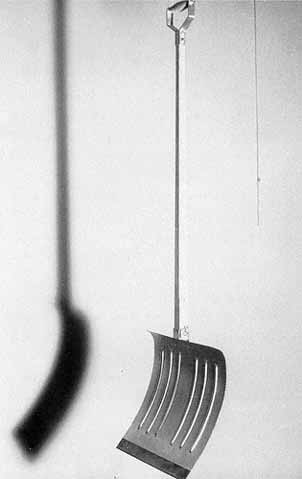
Fig. 42.
Marcel Duchamp, in Advance of the Broken Arm (En avance
du Bras Cassé), 1964 (original version of 1915, lost). Ready-made:
wood and galvanized iron snow shovel, height 52 in. Yale
University Art Gallery, gift of Katherine S. Dreier to the
Collection Société Anonyme. Courtesy of Arturo Schwarz.
(faire )[52] Savagery (sauvagerie ) is a figurative expression for designating unsociable, uncultured, or unsavory behavior. Now we begin to understand that Duchamp's punning inscription on the comb may refer to the iron (y) of his position as an artist who abandons one form of creativity, that of making paintings (which he associates with savagery of the splash and odor of paint), in order to adopt another form of making, which is conceptual rather than artistic in the traditional sense. The ready-made embodies this new form of non- or an-artistic making, since it involves intellectual, rather than manual work.
If this inference seems a little farfetched, it is possible to confirm it by rapidly examining other ready-mades: the bottle rack, Bottle Dryer (1914), and the snow shovel, In Advance of the Broken Arm (En avance du bras cassé; 1964 version [original version of 1915, lost]) (fig. 42), both articles made of galvanized iron and suspended in the air. In the previous
discussion on puns the bottle rack was examined as a mechanical analogue of linguistic puns. The function of this object as a bottle dryer, however, makes one wonder whether this object is intended as an example of "dry art," that is, as yet another instance of Duchamp's rejection of painting (which he associates with the wetness of paint). The snow shovel is also an example of "dry art" to the extent that the liquidity of water must crystallize into snow (a solid, dry powder) in order to be shoveled. The snow shovel (pelle à neige) begins to make sense, once one literally spells out (épeler ) its punning associations. Shovel (pelle, in French), which means scoop or blade, can also be used to signify dustpan (pelle à poussière) or a fall off of a bicycle. One only has to recall Man Ray's and Duchamp's photograph Dust Breeding —a picture of the Large Glass lying flat and showing the accumulation of dust—to realize Duchamp's leap from the colorless snow to the insignificant grayness of dust. Like Leonardo before him, who recognized the plastic and temporal potential of dust since he saw in its reliefs a miniature terrain and also recommended using it as a device for measuring time, so, too, does Duchamp begin to breed dust.[53] Mimicking his affection for "gray matter," or "brain facts," the dust becomes both a symptom of the temporal erosion
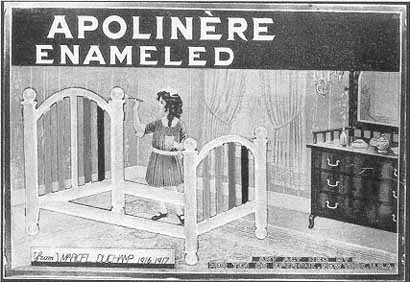
Fig. 43
Marcel Duchamp, Apolinère Enameled, 1916–17. Ready-made: cardboard and
painted tin advertisement for Sapolin brand of enamels, 9 5/8 x 13 3/8 in.
Courtesy of The Philadelphia Museum of Art, Louise and Walter Arensberg Collection.
of the traditions of painting (its "gathering dust") and, paradoxically, a statement about the conceptual future made visible by this very decline.[54] If painting implies being in the "color" business, Duchamp demonstrates that he will have no hand in it. Is it then surprising that the snow shovel is entitled In Advance of the Broken Arm?
But if Duchamp will have no hand in painting, does that mean that he stops making art altogether? Or does it mean that someone else picks up the relay, another person, or perhaps, another persona? In order to examine these questions, we turn to another of Duchamp's ready-mades, Apolinèere Enameled (1916–17) (fig. 43), a cardboard and painted tin advertisement for the Sapolin brand of enamels. Duchamp alters this advertisement by covering some letters in black paint and adding in new letters, so that "Sapolin Enamel" became "Apolinèere Enameled." By drawing a reflection of the girl's hair (in pencil) in the mirror above the chest of drawers, he adds new visual details to the original image. Moreover, he transforms the commercial slogan, printed on the bottom right-hand side of the image, into what appears to be a nonsensical message: "Any act red by her ten or epergne." Carol P. James interprets this complicated visual and linguistic rebus as the scene of a narration, which Duchamp renarrates to his own ends:
The scene of the little girl who wields a paint brush as she would her comb (her hair, sketched in by Duchamp, is reflected in a mirror), as a practical gesture, is a sort of allegory of the ready-made where artists who paint ("peignent") give up their brushes to choose everyday objects like the comb ("peigne").[55]
James's remarks correctly identify this scene as an allegorical reflection on Duchamp's dilemma as an artist who gives up the traditional means of painting (the brush), in favor of conceptual and poetic tools embodied in the ready-made as a pun. Instead of representing (enameling or embellishing) by using paints, Duchamp chooses to depict not by using colors but by resorting to poetic forms of expression. Hence the title of this work, Apolinère Enameled, is a pun on the name of the poet Guillaume ApolliNaire (1880–1918).
But why would Duchamp choose to represent his own dilemmas as an
artist seeking to question the limits of art, in the form of a little girl wielding a brush? By drawing in the girl's "hair" as a reflection in the mirror, Duchamp literally designates her legacy as an "heir." "Heir" is, however, also a pun on the French pronunciation of the letter "r" (air, ) which in English is pronounced as "arh" (the same as art, in French). This pun on art is a reference to another ready-made, Paris Air (fig. 44), a glass ampule accompanied by a printed label "Serum Physiologique." Serum is a yellowish, clear, watery fluid drawn from blood that has been made immune through inoculation.[56] The punning analogies of air and art reveal the fact that the heir to painting may be engaged in a bloodless, or rather, a colorless task. The inscription on the right-hand bottom, "Any act red by her ten or epergne," now becomes less enigmatic, since it stages allusions to the color (red), to reading "any act red" and to painting (the comb, peigne, as a pun on epergne). Epergne can also be read as a pun on thrift or savings (épargne , in French), thereby suggesting that painting may be kept at bay, or safeguarded against itself, through its read (red) or ready-made embodiment as a pun.
Given Duchamp's critique of ocular (oculiste ) art, it is not surprising that this image, which depicts a little girl painting, also functions as a pun on Duchamp's own legacy, an immunity to painting guaranteed through in(ocul)ation. The signature "[from] Marcel Duchamp 1916–1917" designates the gesture of authorship both as an issue (coming from someone and issued to someone else) and as a temporal interval, a space that shatters the self-identity of authorship through circulation. This signature no longer designates Duchamp, but rather his displacement as an authorial persona. Rather than functioning simply as a postcard (an item circulated through the mail, also a pun on male), this work marks both the displacement of the authority of painting and its future reissue (its post, or future legacy) as the impossibility of art.[57] Thierry de Duve's comments regarding Duchamp's painting, The PASSAGE from the Virgin to the Bride, anticipate the paradoxes that are explicitly spelled out in Apolinère Enameled: "Marcel Duchamp, painter, signs the impossibility of painting while Rrose Sélavy, artist, depicts (dépeint ) art's possibility. Unless what happens is really that the anartist Marcel Duchamp designates the possibility of painting while the nonpainter Rrose Sélavy paints the impossibility of art."[58] The issue, however, is less one of deciding who exactly (Marcel or
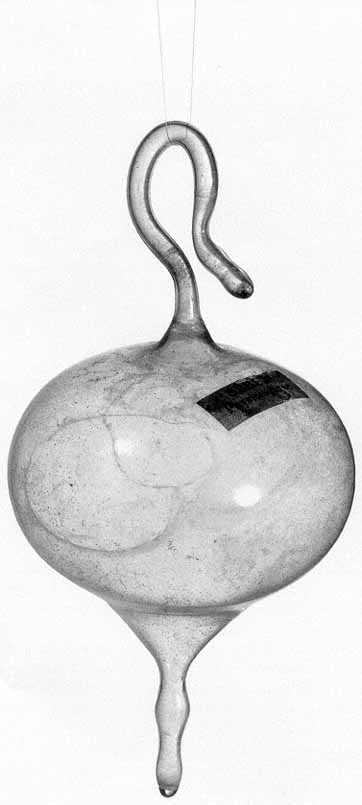
Fig. 44.
Marcel Duchamp, Paris Air (Air De Paris), 1919. Readymade: glass ampule, height 514 in.
Courtesy of The Philadelphia Museum of Art, Louise and Walter Arensberg Collection.
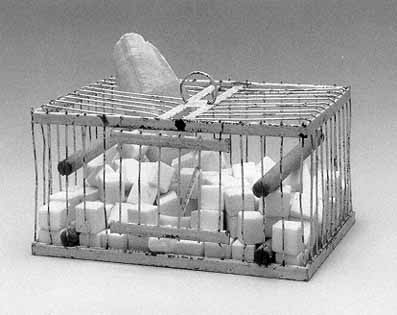
Fig. 45.
Marcel Duchamp, "Why Not Sneeze Rrose Sélavy'," 1921 Semi-ready-made: 152
marble cubes with thermometer and cuttlebone in small birdcage, 4 1/2 x 8 5/8 x 6 1/4 in.
Courtesy of The Philadelphia Museum of Art, Louise and Walter Arensberg Collection.
Rrose) depicts the possibility or impossibility of painting or art, but rather the fact that these positions act as mechanical relays that may be switched on or off, like puns. As our subsequent discussion will show, the reversibility of these positions can only be understood by conceiving them according to the poetic and thus reversible logic of puns, as instances of "mirrorical return."
Duchamp's gestures embody a logical impossibility, since affirmation and denial, past and future, male and female coexist within Apolinère Enameled. But this very coexistence shatters the identity of the artist, who now embodies not only different positions, but also differently gendered personas—Marcel Duchamp and the little girl. Heralding the appearance of Duchamp's artistic alter ego Rrose Sélavy, this little girl is not someone to be taken lightly or even sneezed at. After all, she will go on to sign and thus authorize Duchamp's semi-ready-made, "Why Not Sneeze Rrose Sélavy?" (1921) (fig. 45), a birdcage filled with marble cubes in the shape of sugar lumps with a thermometer and cuttlebone. The cuttlebone is a fig-
urative expression for commerce (the cuttlebone of commerce) and thus an indicator of Duchamp's particular dealings (affairs) with both painting and the notion of authorship. This work, like Apolinère Enameled, suggests that authorship is not fixed referentially, since it cannot be contained by the identity of the artist. Considered in these terms, authorship emerges as a process of engenderment, a commercial and erotic affair, which sets the author into motion as a relay of personas, thereby delaying, and thus postponing, the author or artist from attaining a proper or fixed identity.